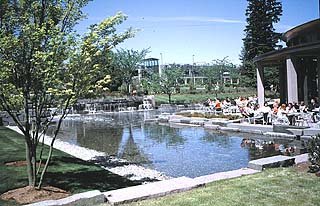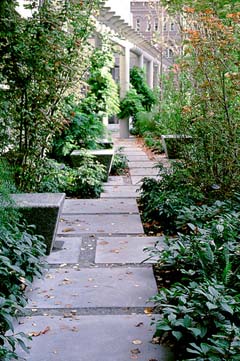
Surveys
DJC.COM
April 18, 2002
Healing gardens take many forms
Murase Associates

Employess can relax by this water feature at the Safeco campus in Redmond. |
Especially in these times, garden spaces can be places where we go to feel well again.
What is a healing garden? In the October 2001 issue of Landscape Architecture Magazine, Clare Cooper Marcus identified seven essential components to creating gardens that heal.
They are:
-
1. Visibility
2. Sense of security
3. Physiological comfort
4. Opportunities to make choices—seeking privacy or gathering for social support
5. Engagement with nature
6. Familiarity
7. Unambiguously positive design features
The healing garden can possess one or many of the above characteristics, according to Marcus. Framed in this way, the definition is broad and inclusive.
It can be as private and simple as the medicinal plants in your windowsill or as public and monumental as Murase Associates’ Garden of Remembrance at Benaroya Hall. It may be intended primarily for the individual or for shared experience, and for any age group. It could be a plaza used by office workers during their lunch hour, a forest trail, a park or even a childrens’ play area. One example of the latter is being planned in Seattle to remember a neighborhood’s child victims of Alaska Airlines flight 261.
More and more we know that healing must be focused more broadly than pills and conventional medical treatments. A deeper understanding of health and well being is required. In this more holistic approach, the garden can be seen as an instrument for the healing of mind, body and spirit.
At Nisho Awai Garden on Nike’s World Campus in Portland and Safeco’s Corporate Campus in Redmond, the clients were very committed landscapes that were not only beautiful but also places where employees could find rest and relaxation. In both of these projects, water animates the landscape, whether viewed from inside the building or sitting next to it. Sometimes the water is reflective, quiet and still, mirroring the sky. In other places there is movement, energy and sound as water flows over stone weirs.

Garden of rememberance at Benaroya Hall. |
The landscape is not just one element but a microcosm of nature in which static and dynamic processes are balanced.
Stone paving, ledge stone walls and large rough-hewn stone blocks are used to create a rugged sense of nature yet are sufficiently ‘architectural’ in shape so as not to detach nature from architecture. In the process, a subconscious harmony and sense of well-being is achieved by unifying the indoor and outdoor environments of employees. Plants are selected for their fragrance, form and seasonal interest. The fragrance of sarcococca (Himalayan Sweetbox) in January, the vivid colors of autumn and lush greens of summer, the sway of ornamental grasses in a light summer breeze all conspire to create a place of inspiration and relaxation.
Several seating options are provided that can be used individually or in small groupings. Moveable furniture lets people choose where they want to sit in relation to sun and landscape. Stone blocks seats are one with nature.
Opportunities for quiet meditation and reflection while at work are very important. It has been said that “Half an hour’s meditation is essential, except when you are very busy. Then a full hour is necessary.” The stresses of everyday life can become debilitating without relief.
In medical environments the emotional and physical needs of patients, families and healthcare workers must be considered. For the sick or dying, a place where people can engage with all of their senses is very nourishing. The elements of nature in all their forms are a very powerful symbol of life—and death. For healthcare workers or the family of the sick, the needs may be different but no less important for alleviating physical or emotional stress. Caregivers, patients and family may find peace and comfort in the garden if it provides the backdrop for positive encounters. Plant and materials selection, colors, sound, texture and fragrance all are extremely important whether we are designing the garden to promote the health of mind, body, soul or all of the above.
In Edson Park and Towne Court at Fred Hutchinson Cancer Research Center, it was necessary to create very energetic water features to mask traffic noise. Symbolically, the power of nature is very much evident. A quieter experience is possible near the reflecting pool adjacent to the main pool in Edson Park. In addition to offering a refreshing antidote to the clinical environment of the research facility, water is a wonderful and fluid symbol of life.
The layout of stone paving is very irregular in relation to the regular architecture of the building and this creates a sense of mystery and challenge. In the Towne Court Garden, one can seek privacy in a secure enclosed courtyard. Moveable furniture lets people sit alone or with one another for social support. In these gardens, plants were selected primarily for foliage, flower color and fragrance. However, in other healing gardens, plants such as St. John’s Wort, fennel, lemon balm and burdock that continue to be used today to cure physical or mental ailments, are used symbolically.
As nourishment to a grieving soul, a healing garden may take the form of a memorial garden. The Garden of Remembrance at Benaroya Hall in Seattle and the Japanese American Museum in Los Angeles both are places where we can go to reconnect and make peace with lost places or parts of ourselves.
In this respect, memorials become the place where grieving can be safely embraced. We use nature in this context to demonstrate that we are all part of the cycle of life and death. By watching the seasons of life we learn that change in both positive and negative forms is part of the cycle of life and that we will recover from sorrow. In both of these gardens, water is primarily reflective to allow personal contemplation and meditation.
Stone is both natural and symbolic of longevity. However, stone is mostly cut in these two projects, expressing the work of human hands. Elegance, dignity and respect are inherent in both of these designs. Quiet places have been incorporated to allow for more intimate experiences. Plants were chosen in these designs for the symbolism they embody: sculptural forms at the Japanese American Museum and a classic Northwest plant palette at the Garden of Remembrance. Traditionally, trees such as birch, oak and ash offer healing benefits. At the Garden of Remembrance, a large oak tree was planted as a focal point—the traditional tree for remembering those gone off to war.
In our homes, at work, in our communities, in medical environments and in our personal lives, the garden can improve our well being in many ways. Nature exemplifies our life and we can understand the physical and emotional parts of ourselves better by observing and being part of it.
Dean Gregory is an associate landscape architect with Murase Associates in Seattle.
Other Stories:
- Greenbacks in the greenery
- Blending scenery and ecology
- Gorillas help build their new Hawaiian home
- An evergreen manifesto
- Finding an identity in the forest
- The street becomes a stage: New roles for roads
- Lifting our sights beyond ‘our’ sites
- Volcanic legacies
- Collaborating from the ground up
Copyright ©2009 Seattle Daily Journal and DJC.COM.
Comments? Questions? Contact us.